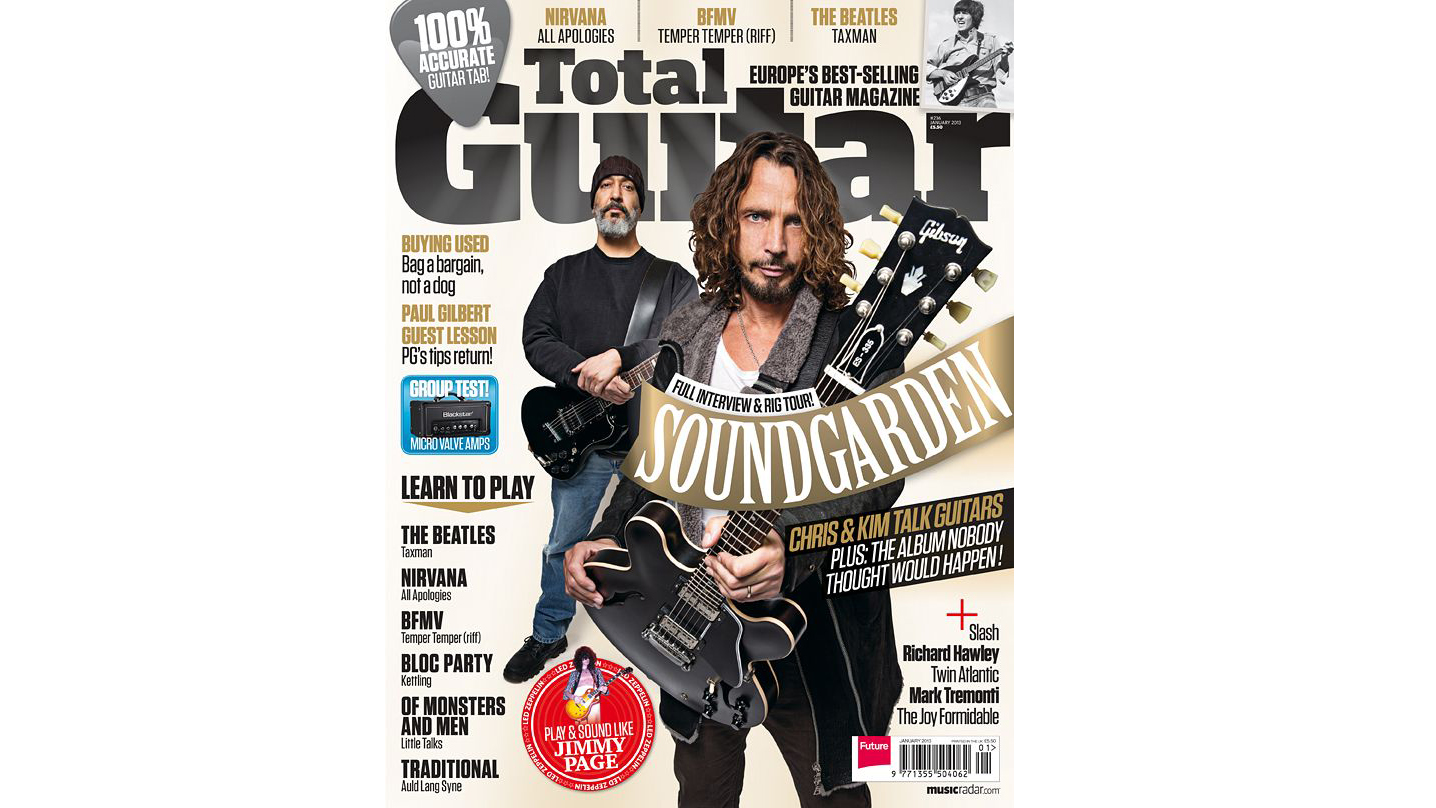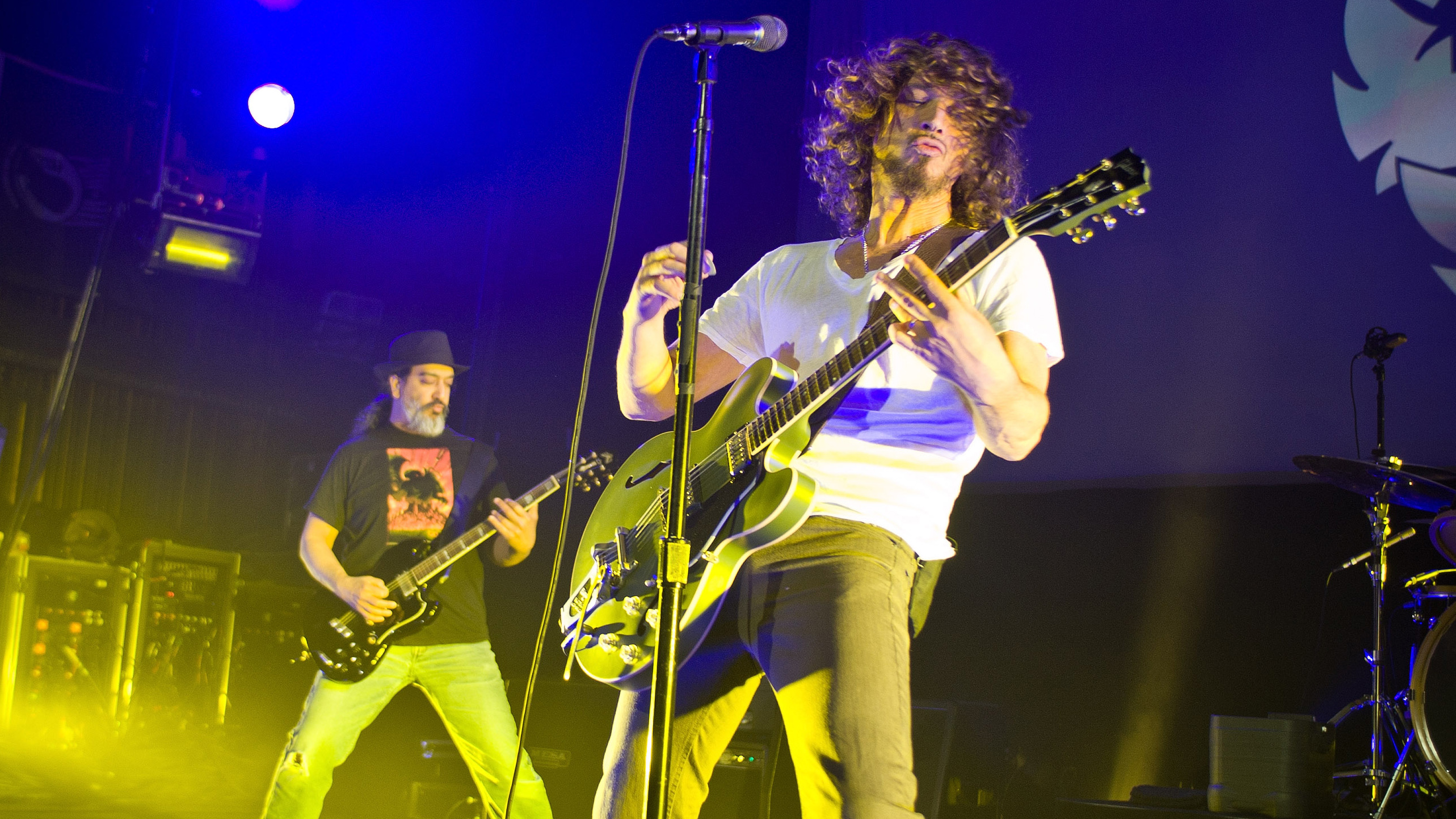
In 2012 Total Guitar's Rob Laing spoke to both Chris Cornell and Kim Thayil in separate interviews about their comeback album King Animal. But they also delved deeper into their relationship with guitar, and how they viewed each other as players.
Looking back this is an interview shadowed with sadness, not just because of Chris Cornell's passing five years later, but also Ashley Maile, the photographer who shot them for Total Guitar's cover, passed away in 2013. Find out more about Ashley's work here.
Here, for the first time, are the full interviews with Chris and Kim.
Chris Cornell

Did you feel under less pressure with this album?
"But that’s not the end of the world, when you’re a band that was together from 1984 to 1997 and then you split up for 15 years and you’re making an album, what difference does it make really?
"The important thing is that the album is great and that’s what our concern was. I would rather take an extra year to write and record an album to make our fans happy than rush an album out that they don’t like.”
How did it feel for you to go back to a band unit with four active songwriters again?
Want all the hottest music and gear news, reviews, deals, features and more, direct to your inbox? Sign up here.
“In a sense it was very comfortable for me – each guy has their own feel musically and I kind of write differently for those feels. Those are three writing relationships that I’m better at that any other ones, with the exception of just writing by myself.
"And even writing songs separately for Soundgarden where I write the whole song I kind of have them in mind. And I have more experience doing that than anything else. It had been so long since I’d done that but it felt really good – it was refreshing and exciting.
"It was one part reminiscent and comfortable, like putting on old clothes, and one part exciting because I had the opportunity to progress with those writing relationships and with this band. To do some things we never did before and maybe refine aspects of what I felt Soundgarden had attempted in the past and maybe didn’t quite pull off.
"Now that we’re rehearsing these [new] songs to play live, I realise how different a lot of this stuff is and different in a way that I think is good, a spontaneous way that Soundgarden is used to."
You’re an underrated guitar player, and a lot of the Soundgarden material is challenging for you to sing and play at the same time – and on the song By Crooked Steps it feels like you’ve really challenged yourself…
“You think? [laughing] I’m still practicing that one! The vocal melody is still in 4/4 while the guitars are in 5… something. It’s something Soundgarden does uniquely well. We’ve had hit singles in 6/4 where nobody ever really noticed that. Or with odd time signature and rhythmic changes sometimes, particularly for a song that’s played on the radio.
"This song is like that – particularly the way the vocals sing over the guitar rhythms, it sounds almost like a straight rock song but there’s something askew. But it’s not obvious where you’re sitting there thinking about it. It just happens.
"That was the first song we worked on where I felt that we were taking what it is that we do to a new level. And at the same time it’s definitely the most challenging one to sing and play. To just sing it would be easy but the singing and playing part; it’s a new beast. But I’ve run into that before – Rusty Cage was a very difficult song at first.”
"I kind of had to have a have a rebirth of guitar playing"
Chris Cornell
How do you feel that you’ve changed as a guitarist in the fifteen years Soundgarden weren’t together?
“I kind of had to have a have a rebirth of guitar playing really. Around the time I did Euphoria Mourning I took some big leaps in composition and understanding guitar, not so much music theory but changing my perspective on melodies, inversions, chords and song structure.
"That was followed by really stopping playing the guitar for a long time. I guess it’s a post Audioslave thing when I picked the guitar up again and I did a couple of solo albums, then Soundgarden reformed and in the middle of that I started doing acoustic tours. And that was a huge thing for me – that was a different animal.
"You have to play correctly when you’re doing a two and half hour acoustic show because everyone can hear everything. Granted, I have a lot of songs and a huge catalogue and history to draw from and I don’t have to go out there and play everything perfectly but it’s still a sort of naked experience.
"And I grew a lot from that because I played so many shows that way and just figuring out how to relax and play something in that environment when everything is so completely clear. I don’t have any other instruments backing me up and I had to accompany myself only. I’d never done that before.
“And then there was some of the complexity of the new Soundgarden album, having to play and sing on it. It’s definitely helped me with the sudoku of guitar playing I think. It’s helped me increase my capacity to understand it because I don’t think I’m a natural guitar player.”
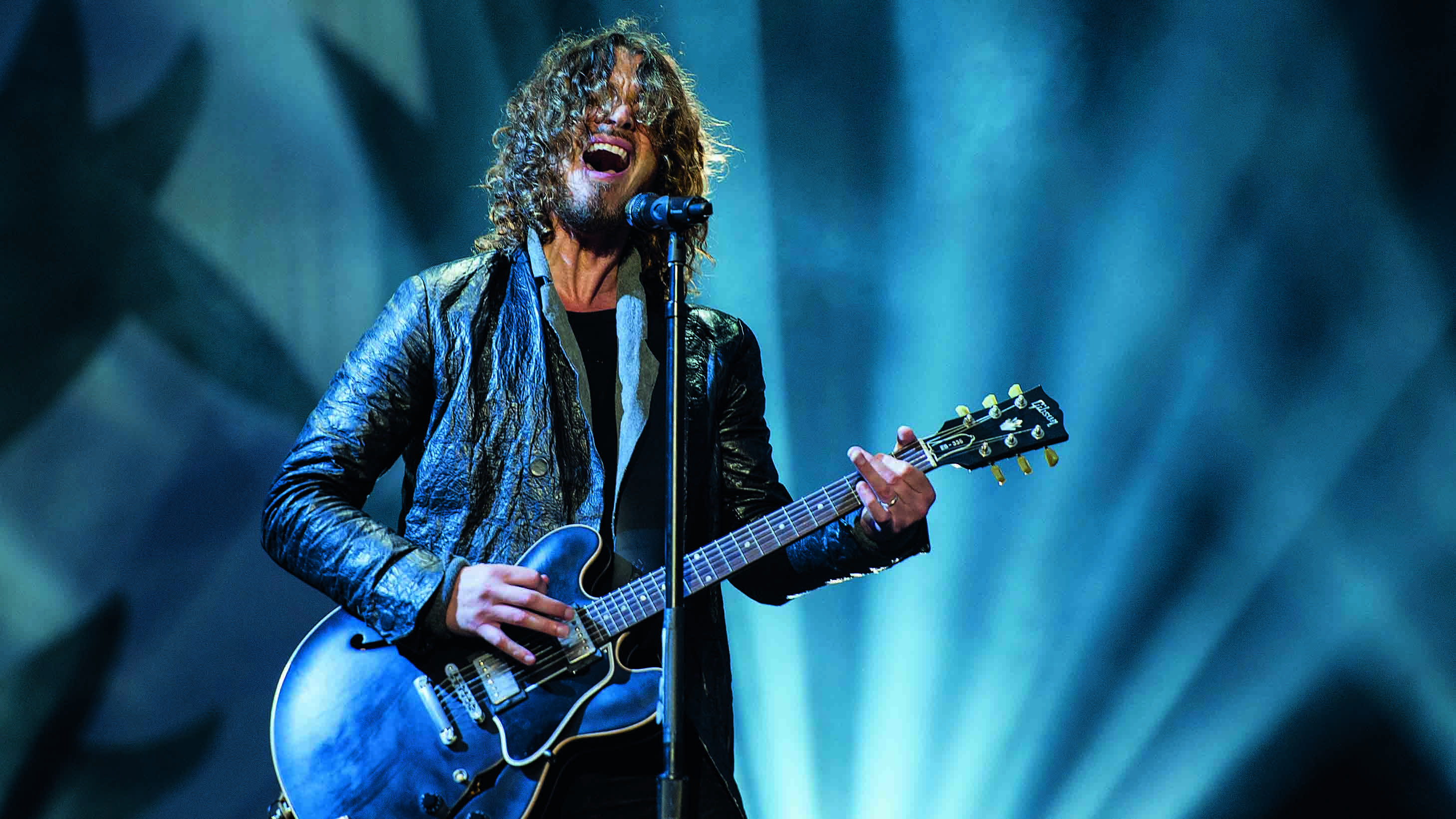
With that in mind, did you and Kim worked closely together on A Thousand Days Before?
“I suppose this is always the case [that] I’m never really sure what I should play guitar-wise. Even though I’ve played guitar in Soundgarden for a long time and written a lot of songs for Soundgarden, I didn’t start out as a guitar player in Soundgarden. I actually started out as a drummer.
"Though I contributed a couple of things here and there in the very beginning it wasn’t my role. And that perspective has stayed in that I always have to approach it one song at a time. If it’s a song that I’ve written then obviously I’m going to play guitar on it.
"For example, if it’s a song that Ben or Matt has written I feel like maybe they should be the second guitar player on it because it’s a feel thing. It’s something they are going to intrinsically have and why should I be learning it and trying to so something that they can easily do.
“So something like A Thousand Days before, I let Kim play and stack up different layers of ideas and things he wanted to do on it before I ever touched it. Then I felt like, Ok I do have a place on it in terms of what it’s missing and added a couple of simple things. But very little – I play very little on that.
“On Blood On The Valley Floor, I didn’t play guitar on it, it was just Kim. And that made sense to me. Though it’s a new arrangement it also reminded me of early Soundgarden songs where Kim would come in with this whole concept and play it. It was very much playing in his feel and there’s no reason for me to play on it.”
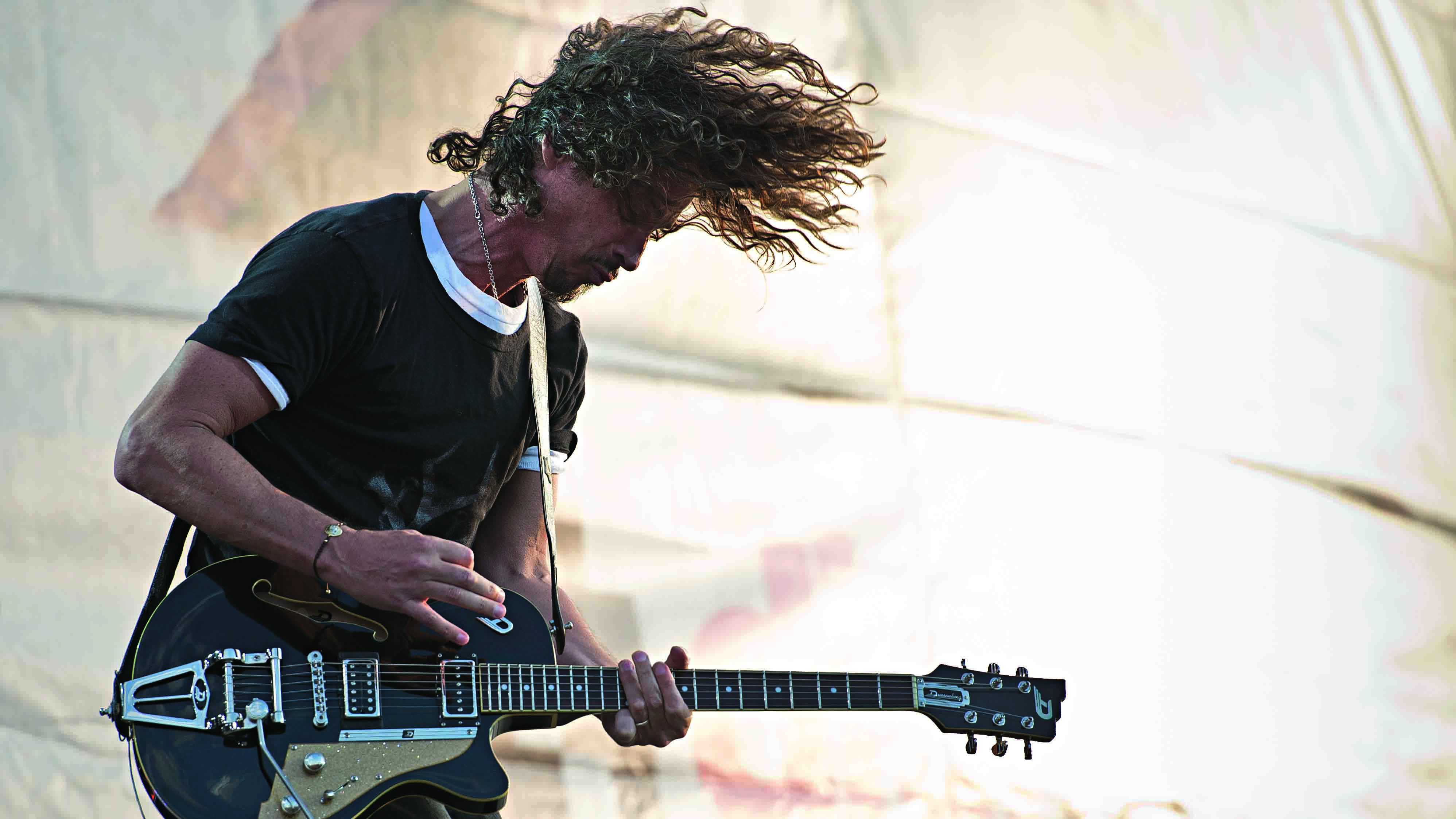
You’re a band that’s been very experimental and adventurous with alternate tunings – what usually comes first in your writing, the tuning or the melodic idea itself?
“For example, for Been Away Too Long, I had an old Gretsch hollow body that was hanging on the wall in my hallway that was in that tuning [EEBBBB] and I just took it off the wall one day and I just strummed it. I didn’t know what tuning it was in but I just strummed that basic riff out of the blue.
"A couple of days later that song was going through my head so I figured, ok I’ll make a song out of it. It just happened that was the tuning the guitar was in and that’s similar to a lot of songs I’ve written in weird tunings in that I’ll be working on one song… like that tuning from Been Away Too Long is made up of Es and Bs was originally introduced to me from Ben on a song he wrote called Somewhere that was on Badmotorfinger.
"Sitting around practicing that and holding a guitar in that tuning I came up with other ideas. My Wave is in that tuning and that came from a riff that I played in a rehearsal when we were practicing Somewhere – it became that song.
"It’s a little bit more about proximity to the tuning as opposed to picking up a guitar, putting it into a weird tuning and then trying to create something out of it. There’s some reason to be holding a guitar in that tuning and you’re noodling around and something cool comes out of it.
“Over the last few years I’ve been learning Nick Drake songs and there’s some pretty subtle tuning changes that create these very specific kind of open auras musically. It’s difficult to write in those without sounding like that sprightly, sparkly pastoral Nick Drake thing. But it does help create new ideas in a sense when you’re sitting there.”
Kim’s bringing some really interesting textures to this album – do you view him as a lead guitarist in the traditional sense?
“Well Kim and I have actually had long conversations about that, including on this album where he wanted, rather than be called lead guitar, he wanted to maybe be referred to as colour guitar.
"That’s great but maybe there’s room for misinterpretation; maybe someone reads that and thinks, Oh you’re just sitting around playing sounds. He doesn’t play lead guitar in the way that we understand it and he never liked that moniker because a lead guitar refers [for me and him] to the shredder Yngwie Malmsteen, Eddie Van Halen approach to lead guitar. And he’s always rejected that – even though he could play like that and occasionally you’ll hear it, it’s not what he likes.
"His approach is more atmospheric and more stream of consciousness. He doesn’t construct leads, he sits and plays over a song and comes up with strange sounds and approaches – sometimes that comes out as a very hooky melodies and sometimes it’s very atmospheric guitar playing that can be effects-laden or just feedback even.”
What were your main guitars for the album?
“I used a 335 on a couple of things, I have a Gretsch Roc Jet that was a late eighties reissue that I’ve been using ever since Gary Lee Conner from the Screaming Trees gave it to me. That’s a guitar I used a lot for a specific texture I always like.
"I have a Jazzmaster that I used on a couple of things. I play a Martin D-28 that I used on a couple of things which is what I used on all my acoustic touring. I have a couple of different Les Pauls and I have a few Bigsbys on a few of those different guitars as well. Which you won’t hear because I use them very subtly but there’s something about even just slightly moving them that just grabs the note and makes it tear off and ring more in a strange way.
"I think it’s because of the size and the amount of metal. If you touch a little bit you’re not necessarily going to hear the vibrato but suddenly it starts to resonate in this barely harmonic way that’s very exclusive to that thing. I’ll have those [parts] in there and I know when they’re in there because I played the parts but it’s the only way to get that tone, that trail of a note or a chord.”
“I used an original Trini Lopez that belonged was Adam Kasper [producer] – sometimes in place of the 335 because it just seemed to voice better. He also has a Martin that I used on something, an acoustic that sounded really good but I don’t know what the model is. But it sounded great.”
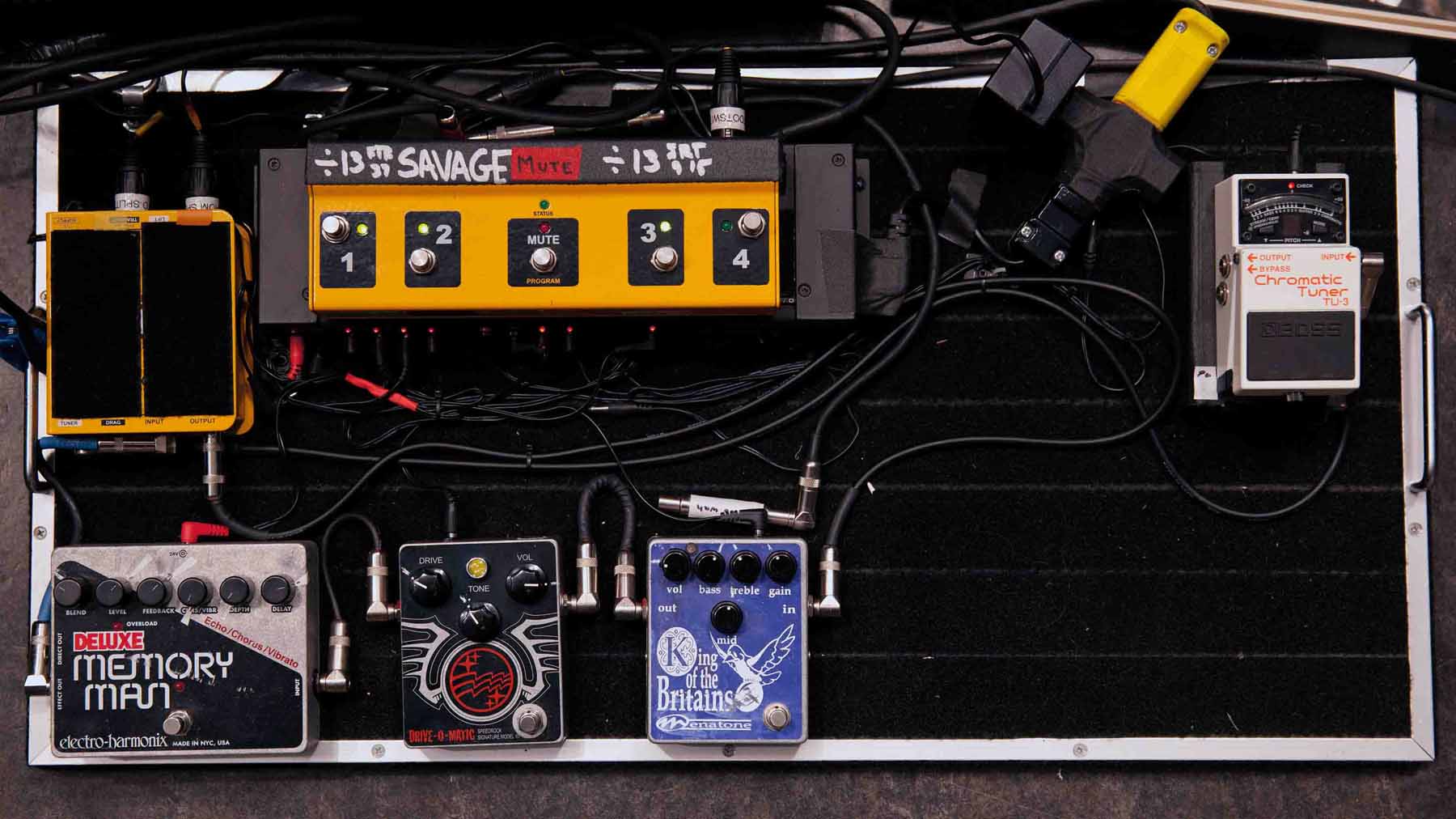
What amps did you gravitate to?
“A couple of Divided By 13s that I’ve used lately. I also used a Fender Pro Junior on a lot of stuff – that initially was set up with a mic on it, but I wanted something very loud in my proximity when I’m playing all the rhythm guitar parts so that I’m kind of fighting feedback the whole time, that’s the point.
"I wanted that recorded, that sense of what it’s like on stage where you’ve got something that isn’t necessarily easily controllable. In modern rock record making for some reason people just seem to comfortably adopt playing in a control room with the speakers mic’d out in the live room. But they’re hearing their guitar from studio speakers. I don’t like to do that.
I think there’s one little film snippet of us when we were releasing this teaser of Worse Dreams where you’ll see me walking up to a [Korg] MS-10 [analogue synth] with my guitar on the MS10 and while I’m doing that I’m trying to get feedback from that while I’m recording. So the Pro Junior was there for that reason just sitting next to me but then it ended up for a lot of the guitar tracks that was the tone I liked the most.
“I will go with whatever sounds good at the time – we also had an old Ampeg combo guitar amp that we were using a lot that was Adam’s. There’s a certain amount of nasty guitar sounds on this album that I’m very happy with as well as vocal sounds.”
"I’m sure there’s a Soundgarden that could be much more lush and perfectly produced and tonally more listenable but this is what we want it to sound like"
Chris Cornell
Do you think using semi-hollow guitars aides that?
“I think that helps and I think a producer engineer that doesn’t constantly fight you on that does as well. That’s been my experience for years. There’s a lushness that producers and engineers gravitate towards because that’s what they think is right. But we as a band have always fought that and we’ve won those battles to some degree.
"But I think on this album, and having Adam who we’ve now worked with on three albums, he doesn’t fight that at all. I have the same experience with vocals – I’ve always tried to push two preamps and compressors in the way that you hear old recordings, where you hear the singer and they set up the volumes but they only get two takes. And then the levels aren’t right and when they’re recording they sing louder and you get this great tube distortion.
"I’ve always wanted that and I’ve always had engineers fight me on that. Now I just do it myself, Adam loves it and it sounds the way we want it to sound. I’m sure there’s a Soundgarden that could be much more lush and perfectly produced and tonally more listenable but this is what we want it to sound like. And that, for me, ends up being the most important thing.
"We know what we should sound like and we spend a lot of time doing it. It might not sound like that, it might sound like we just went in and quickly did it. We actually go to pains to sometimes to get the sounds that are actually on there.”
Kim Thayil
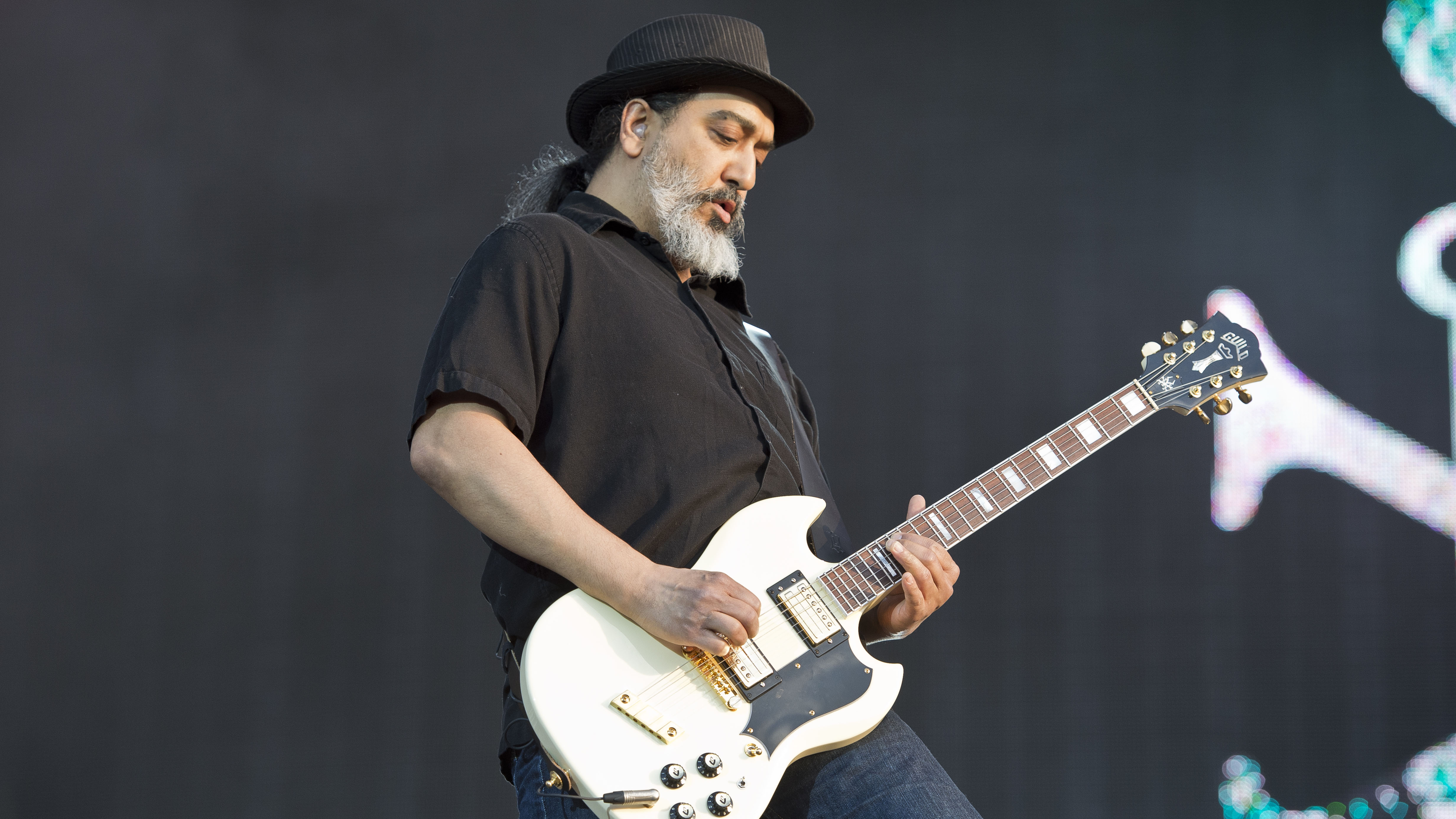
Who got the ball rolling in the band when it came to writing new material?
“It was pretty much Matt, we’ve been utilizing a lot of the resources of the Pearl Jam machine when we first started up [again] and Matt’s the one with the hectic schedule but he managed to make himself even busier!
"So he got us into the studio because he wanted us to learn a couple of songs that he had and he wanted to hear what they would be like if we played them. So that started that and from there on we were jamming and exchanging ideas. And Chris had some demos and everyone else contributed various ideas and the whole process started again.”
Did you let the process evolve naturally without pressure?
“Yes because there’s no expectation – there was no record contract, no plan for an album there. We weren’t even 100% convinced we were a band anymore other than a partnership attending to its catalogue and playing a handful of shows.
"This is two years ago when we started back in the studio. It’s unbelievable – the process was extended because of various breaks to fulfil other commitments like solo tours, Pearl Jam tours, our producer also had other projects.”
Did you have any ideas that you had stockpiled over the years in the event of a Soundgarden reunion?
“I don’t think we did collectively because we didn’t expect to get back together. I was planning for it and I wasn’t longing for it. But there were probably ideas that were perfect for this band – if I write hard rock songs or certain punk or metal things it’s hard for me not to imagine Chris singing it or Matt playing drums, because it’s so ingrained in my experience. If I’m doing something stylistically different I can kind of get out of that but so much of the way I write really sounds like this band.”
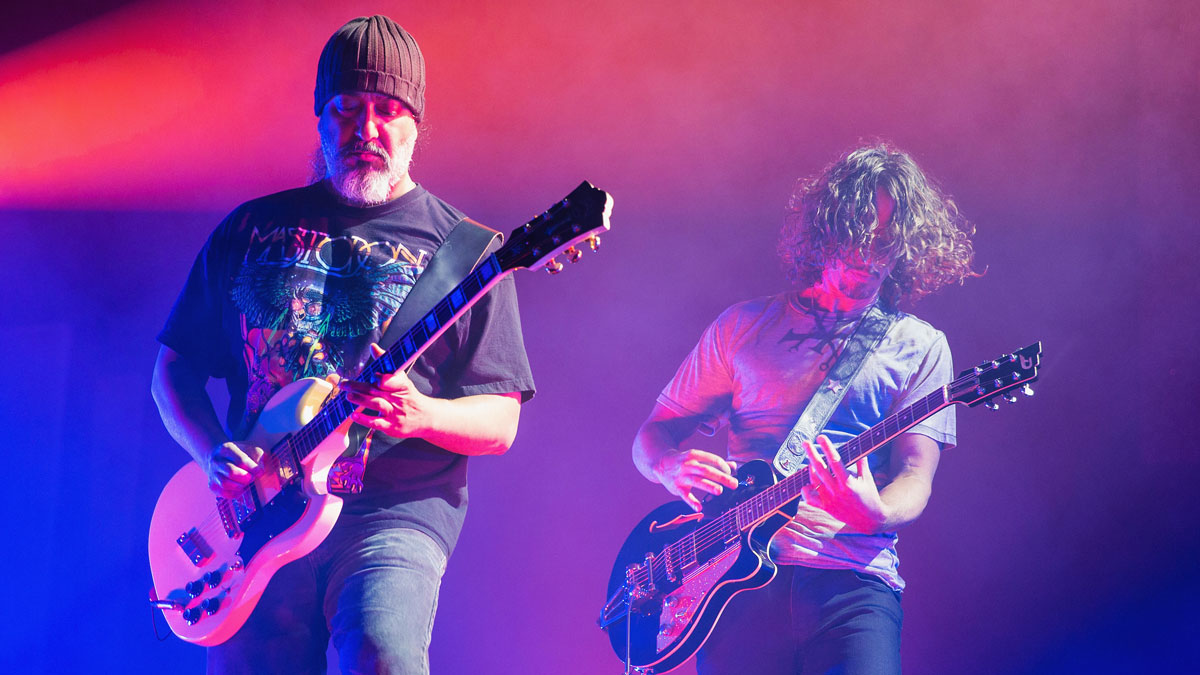
Did you take advantage of the way technology has changed since you were last together – sending ideas over the internet to each other to work on?
“There was a little bit of that only when it was most convenient because people were challenging, other than that it was all done when we were together in Pearl Jam’s rehearsal studios. We would document a lot of the ideas we’d come up with by jamming and we’d document out progress of how well we were learning the songs and how the songs were evolving.
"Chris had a few demos that he brought up to us, gave us copies and we’d learn the demo as it was and in many cases the songs would start changing and as we began playing and jamming them. A few of Chris'’ ideas were just instrumental so we could only sit there and anticipate how the song would be fully transformed with lyrics.”
How did Non State Actor come about?
“Ben [Shepherd, bass] wrote all the ideas and riffs and the arrangement was basically Ben’s but the whole band contributed to reworking it. We spent a lot of time working on that song in rehearsals because that was a very hands-on song that kept changing; is this arrangement emphasising this second riff too much so do we go back to emphasising the first one?’ ‘Is this riff that we love to play on guitar not occurring frequently enough? How do we bring it back… it’s been a minute and a half we’ve got to get this part of the song back in there. Do we do a guitar solo?
"Ben had all the guitar lines and then we had to glue them together in a way that would suite the dynamic development of the song and would then give a place for lyrics to go.”
By Crooked Steps sound like a very collaborative song
“Matt introduced the main riff and as we jammed with it a lot of the other elements came to be – that really quick ending riff that sounds like a Jimmy Page riff, Ben wrote that on bass and we ended up figuring it out on guitar.
"The middle section, that dreamy part that sounds fluid that’s something I can came up with and the Who-like slashing chords over the Jimmy Page riff, I came up with those and then the intro melody, that sound I think is evocative of a highway horizon… it all came together bit by bit.
"We’d add different musical ideas. Then Chris took the tape and he moved some sections around to fit the lyrics, brought them back to practice and we all thought, ‘excellent’ and then from there the song moved again to include instrumental parts in the ending and the middle.”
That kind of collaboration and use of odd timing is not a new thing for Soundgarden
“We’ve always done that. Jesus Christ Pose was a similar process to the writing of By Crooked Steps.”
How did you get the feedback at the end?
“I think that’s using an ES-335… wither Chris’ or Adam Kaspar’s Trini Lopez model. I may have been using that and it has a nice distance between the tailpiece and the bridge and resonance. You can add a bit of delay, crank the gain and you get that squealing sound from playing beneath the bridge. I know a lot of folks do that more these days.
"I think the rest of it is just your fingers. I might even be pulling some of the strings off the neck. There was definitely a song I was doing that with the Trini Lopez – bending the low E string off the neck. Then of course it has to do with the tuning you’re in because that will effect whatever harmonic squeal you get and I haven’t mapped that out, it’s one of those things you kind of catch when you’re playing along with something."
"I go into guitar stores and think, look at all the pretty colours and all the shapes, let’s go over to the grocery store now and get some beer"
Kim Thayil
So have you been converted to the idea of using semi-hollow guitars now?
“I’m not a fan of semi-hollows, I just like the action of the ES-335 and always have since I was a teenager. I’m surprised I never got one myself. But I’m not much of a shopper – I’m not a fan of going to stores. I can go to stores if I’m looking for records, books or beer otherwise I’m not much of a shopper. I go into guitar stores and think, look at all the pretty colours and all the shapes, let’s go over to the grocery store now and get some beer, let’s go over there and look at records.”
You’re still very loyal to your Guilds then?
“I also have a couple of S-300s now as well, they made them briefly in the late 1970s/early ‘80s which are a different body shape and they come stock with DiMarzio Super Distortion and I believe a Di Marzio PAF. They’re pretty growly, loud guitars.
"But I like the action on the S100 and it can do other things that allow little personality quirks to come through. The S-300 is a great sound, it’s a powerful guitar but it doesn’t have that flexibility that I’ve come to adapt to stylistically from the S-100. Perhaps a 335 could do some of that!”
Do you play your S100s stock?
“Yes, I always thought the stock pickups were pretty hot when they came out. I must have been about 18 or 19. I think what it was is they just had really good action and the pickups were kind of heightened with the action nice and low so it just got louder than my friend’s Les Paul – those pickups were down closer to the body.”

Do you see yourself as a lead player in the traditional sense? Your role seems more textural than that…
“Chris and I had a conversation about that about a month ago. I think ‘guitar’ was how I referred to my role originally in album covers. I’ve never used lead guitar to distinguish myself from what Chris is doing, he’s often off doing the rhythm parts for songs he’s written, at least originally. I’m usually doing that rhythm riffage as well as guitar solos, I’m often doing a lot of colour stuff and textural stuff.
"We always called it colour guitar, even in the early days and I’m doing most of the solos and improve stuff. Most of my solos are a general framework and then I just kind of wing it every time I play live. As opposed to the traditional metal bands; especially the ones like Iron Maiden and Judas Priest who have the double guitar twin solos where they have to play right on the money because they’re harmonizing each other. Every part is pre-written and scripted, fortunately I don’t have to do that. I know what the general dynamic of the song is and where I’ve gone in the past. Then I just approach the neck there and go ahead.
“Anyway, lead guitar… I was never a fan of that because a lot of our songs don’t have solos – a lot of songs you’d think should have a solo don’t have them. Fell On Black Days has some of my favourite solos and it’s kind of a ballady song. We have some hard rockers that don’t really have much in the way of solos because the fun is in playing the riff.
"One of many things punk rock taught us is that the guitar solo was extraneous"
Kim Thayil
"Playing a solo is taking me away from the part of the song I like playing. So it just depends dynamically, does it really need a guitar solo? Because that is such a rock 'n’ roll cliché formula, especially in the seventies and eighties where not only did every rock song have a guitar solo but many pop songs had guitar solos so it was almost like, here’s a solo to give the singer a break to run over and take sip of his scotch or glass of water… eat a cupcake!
"One of many things punk rock taught us is that the guitar solo was extraneous. It was like this broke appendage to the song. If you strip down and extract the song, the solo was one of the things that was getting in the way of the general message.”
There are a couple of solos on the album with quite a distinctive tone – do you use a POG on the ones in Taree and Blood On The Valley Floor?
“It might have been the POG on Taree, but that was to get it to grit so it stands out on the track that way. I think it’s the way of approaching it too. I’m kind of holding the string down a little bit harder and using a heavier gauge pick. Most of my solos tend to be more fluid with a lighter pick. It’s kind of bending around but on Taree I’m hitting it as though I’m trying to cut through the strings.
“Blood On The Valley Floor is kind of a slashing drone solo – I’m sliding with some open strings but I’m doing a two finger octave. At the same time I’m sliding and droning I’m also slashing at it. The solo is kind of like a three string chord. I built that solo around the initial vocal melody from the Beatles song George Harrison wrote for Within You Without You.
"I was playing the vocal melody for that over the song and kind of making Adam Kasper and our assistant Nate laugh. Then when the solo part came up I started playing that vocal line, we started laughing and stopped recording. But then we thought, that’s a great place to start.”
Another song that recalls George Harrison is A Thousand Days Before – is that largely your own composition?
“Instrumentally it’s all mine. It’s in open C tuning which is a great slide tuning.”
Is that what you used on Superunknown for Half?
“I think we did, and we definitely used it on /Head Down and Never The Machine Forever, I think Burden In My Hand is also in that.”
And Country & Eastern was the working title…
“For obvious reasons – there’s an Indian flavour and a countryish bluegrass flavour. When we had done with it it’s still a rock song though.”
How did you build up the solo?
“I play the solo as if there was a slide because the tuning was a slide tuning. So I start with the mandolin and I actually play the mandolin solo through the whole thing but then I did this guitar solo that’s really a three string solo, I’m bending it but I’m not doing a slide. I’m bending two or three strings, for the most part I was trying to bend three and in some parts maybe only two are sounding but it’s the unison when you get the harmony.
"I did this solo where I really liked the melody and then ran another track to try and duplicate the solo and got it, it sounded like bagpipes. I specifically reminded me of two of my favourite Velvet Underground songs which are perhaps my favourites because of the solos; What Goes On and Rock N’ Roll.
"If you remember those solos they had that weird doubled guitar that’s quite bagpipey. Very psychedelic but has this oestrogen element to it as opposed to testosterone. It’s a floating internal sort of thing. Then we were left with a decision – are we going to do the guitar solo or mandolin solo. God I love them both. I really liked the top end of the solo with the mandolin so you’ve got this thin high little thing that’s a like a little beatle running around the song and then it opens up like a butterfly with the doubled guitar solo. Adam and I were shaking our hands on that one, I think we had to pop a couple of Guinesses.
“But at the end of the song there is some slide guitar, and trumpet and trombone. The trumpet solo reminds me of Ennio Morricone and a little bit of slide to confuse the whole mess and make it more intense.”
The harmonics from you on Bones Of Birds really make an impact – did you have that part in mind from the first time you heard it?
“The song’s melody is really nice but instrumentally it seemed flat to me. There were obviously some parts that needed to punch through or open up, like a flower. The harmonics certainly evoked that kind of visual and worked there.
There wasn’t room for a traditional, linear guitar solo and we didn’t want to clutter up the space because a lot of the space in the song is implied by the fact the riff is single notes and then there’s octaves and every once in a while you go to the chords. But there is a space feel to it, but also a flat feel. So we needed to open up but at the same time not clutter the space that was part of the charm of the song.
"You could imply that dark ambience so the harmonic was the best thing, it was one top of riffs for the chorus. It was a melody line and didn’t seem to clutter the song at all. It was simple but made it three-dimensional.”
How did you get the bird sounds at the end?
“That sounds like a murder of crows or gulls? That is a squealing feedback going through a wah wah with delay on it. So I kept my volume pedal off and I’m simultaneously bending and turning the volume on the guitar up just to the point when it starts squealing.
"At that point I’m navigating around the delay pots and getting it to bend and squeal. It was something we had learned Pink Floyd had done, I think on the album Meddle, and I think The Who did it on Quadrophenia.”
Worse Dreams has a Sabbath feel to the riff…
“First we initially thought that riff was reminiscent of Lucifer Sam off of Pink Floyd’s Piper At The Gates Of Dawn. Once I did the guitar textural stuff it kind of had an ambience that reminded me of Bauhaus, the album In The Flat Field. We’re not listening to those records and thinking, let’s do something like that but when we’re doing something we reference it by saying, God that reminds me of The Stooges, Hendrix or in this case, it has a 1960s Peter Gunn spy feel and Lucifer Sam too.
"Once we added all these other textures it was imagine you’re Daniel Ash playing on some Bauhausey thing. It kind of changes at the end with the duel leads with pretty heavy delay on them. Which I think distinguishes itself from early Pink Floyd and Bauhaus!”
"In the open C and D position you have a lot of droning strings, unison chords and all kinds of interesting patterns – we used to call droning strings sympathetic notes"
Kim Thayil
Soundgarden have always been very experimental with tunings – what comes first for you, the song idea or the tuning?
“The tuning usually facilitates the finger patterns that one will make. When we did the drop D tuning in the early days we’d always go to that fifth chord position with one finger holding down the E,A and D strings. We stay away from that position in drop d tuning now because it would bore us. But in the early days we did that with Flower and Beyond The Wheel.
"Now, in Drop D we do other things but when you plug in with Drop D you tend to move there and make that pattern, like in standard tuning you make the regular Ramones position. In the open C and D position you have a lot of droning strings, unison chords and all kinds of interesting patterns – we used to call droning strings sympathetic notes, like in a sitar but it’s been pretty well established in guitar too.
“Sometimes you pick a tuning because it’s going to drop the song down lower and the guitar will sound heavier. But there’s a limit to that because if you detune continually and think that your riff in standard tuning is just going to become heavier when you tune down to C it’s not necessarily the case. It might just sound flabby.”
How do you feel that you changed as a player in your time away from the band, and how do you think Chris has changed?
“Chris has really improved as a guitarist. What I’ve noticed is things that were kind of difficult for him to do before, he can do with greater ease now. He’s tighter as a guitarist.
"As a singer Chris plays from his elbow – some lead guitarists play with their wrists and bass players might play with their shoulders"
Kim Thayil
"Because he was our drummer initially he’s always had a great sense of timing. And as a singer he plays from his elbow – some lead guitarists play with their wrists and bass players might play with their shoulders. It might be from his solo tours and records but to my ears, he’s really improved as a guitarist.
"There may have been times in our early albums where I thought his [guitar] sound or style was kind of getting in the way, in this case I don’t feel that at all. It sounds needed and helps open up the song. Maybe it’s the finger vibrato, it seems tighter and more like a guitar player. Which is weird coming from me, who has tried very hard not to do the things that would have me considered a guitar player in any proper sense of the word!
"Ok, now here’s a way in which my guitar playing has changed – I used to really not like much in the way of pedals. I used to use a chorus for arpeggios, harmonics and feedback. In our early days our guitar solos were me sitting in front of the amp going ‘wooowowowowoo’ and with the chorus it was like a UFO landing or something weird.
Later I started favouring the wah wah. Chris was playing guitar more and with the wah wah it allowed the solos and the leads to cut through – it gives some motion to the solo that I started liking a lot.
"Lately with this album I’ve noticed I’m still using the wah but there’s a lot more use of the delay pedal. I never really wanted to waste time with it before but I really became fond of it when writing By Crooked Steps and then later doing Worse Dreams. So now I’m using it on some of our older songs with selected parts of solos like Slaves & Bulldozers and Black Hole Sun.”
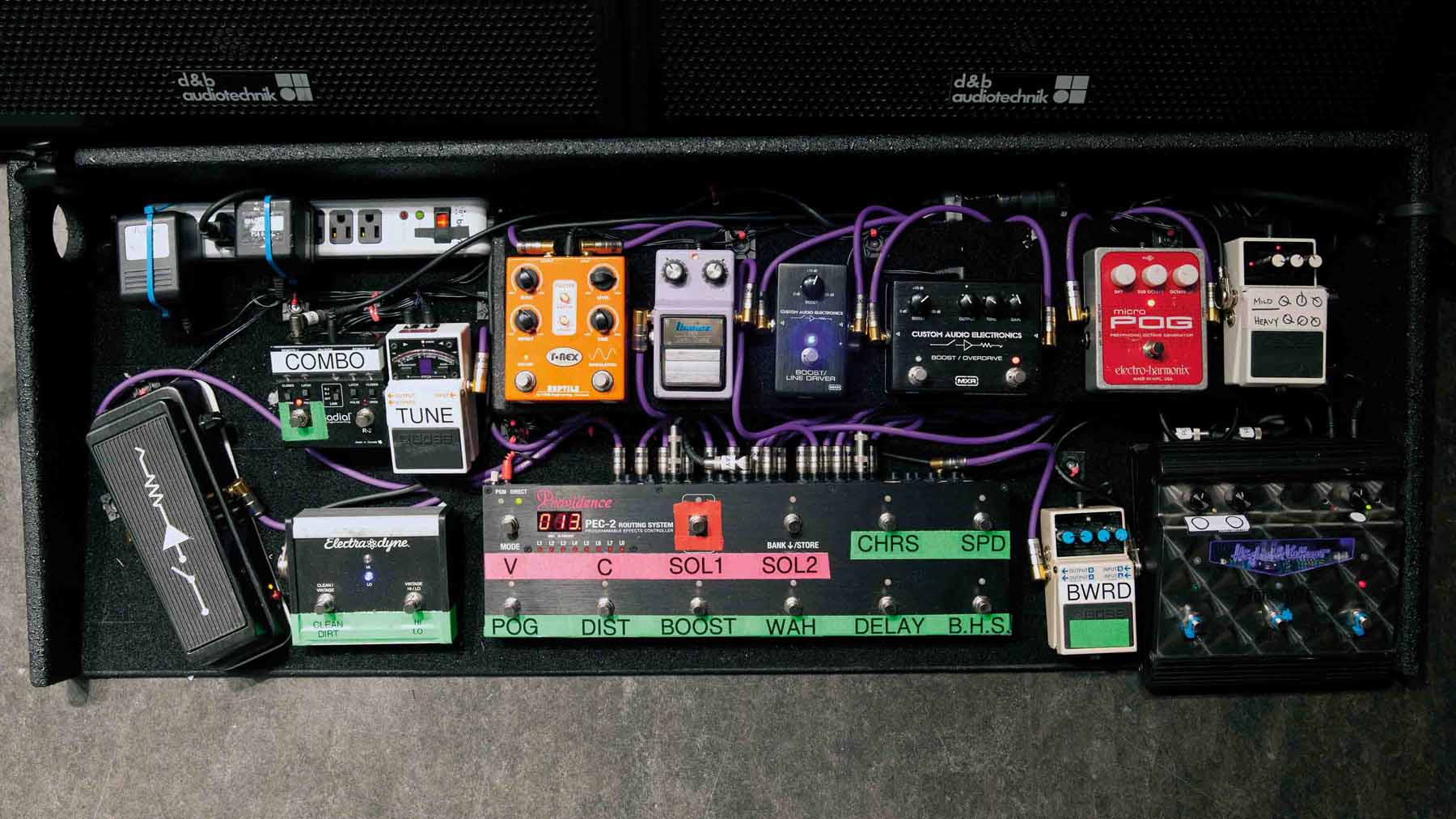
What pedal is it?
“A T-Rex [Reptile] – Chris gave it to me. That’s been one of the histories of the band – Chris buys some pedal and I end up using it, really liking it and then it becomes mine! So Chris has been my pedal supplier over the years – starting with the very first chorus.
"I was playing through Hiro’s [Yamamoto, Soundgarden bassist 1984-1989] bass head and a 15-inch speaker and that was my guitar amp, we’d turn all the low end off and crank the high end then go through a 15-inch speaker – which makes wonderful feedback if you’re playing guitar in a basement.
"Chris said, "We need to cut through a little bit more", so out comes the chorus and the Tubescreamer. The next thing you know I’m using them all the time. So I’ve got to thank Chris for that – handing over some toys, because like I said, I don’t like going to stores. I’m not very good at shopping. It makes me anxious.”
“But going back to your question about lead guitar, I think there might have been a period in the fifties or sixties when it might have been called the front guitarist. Initially you’d think of lead guitar and it kind of got popularised in the sixties, and I though the lead guitarist was the guy with the cool riff and the big heavy chords because that’s what I’m listening to, that’s upfront – that’s lead.
"I was never comfortable with the term lead guitarist"
"Then it was the guys playing the noodly solos and improv. I guess I’m that guy but when I hear the term lead it seems… since the eighties there are a lot of guitarists doing a lot more than soloing. They were doing more textural things. We were doing stuff with feedback, a lead part may be pre-written or it might be an improvisation.
"Bands like Iron Maiden and Judas Priest, they didn’t improvise. Hendrix would totally go all over the place and improvise. Sonic Youth would do stuff that was textural.
"I was never comfortable with the term lead guitarist, I think I always used it initially to distinguish what I’m doing from what Chris is doing. On this album I actually credit myself as lead and colour guitar because the textural things that you pointed out, we’ve always called colour guitar. I do most of it on Superunknown, Chris did a little colour part here and there on songs that he wrote.
"On this record he’s done some feedback things. We’ve always referred to it as colour guitar and we’ve met other guys in bands that know what we’re talking about. Maybe that term is more applicable to what we do. So I used the term colour guitar and maybe the hope was to stop referring to what bands like us do as lead because it seems like a term from a different kind of band."
That’s one of the things that sets Soundgarden apart in a sense – that you won’t compromise that element of your sound, the feedback, tones that aren’t necessarily pretty…
“They might think that’s not playing, that’s noisy. Their allegiance isn’t to the song or to the moment and expression of the song. They might be more intellectually focussed on the construction or maybe the technique on the instrument.
"The song doesn’t need to be a vehicle for the instrument. It could be something that exists on its own and the instrument could be something that helps describe and frame the song.
"That’s the only thing, I don’t like those expectations – well you’re a lead guitarist so you should play more like this. Well, how the hell did popular music ever change if people were always doing what was expected of them? Especially in a genre like rock n’ roll – which was always about rebelliousness and in its finest hour incorporated chaos and wildness with Jimi Hendrix, the MC5, Velvet Underground, Sonic Youth, The Buthole Surfers and Black Flag. Why would anyone expect some degree of conformity and easy reference for what is rock n’ roll when this is the genre where you would least expect behaviour to abide by.
"There’s a lot of that, especially in successful large genres where they seem to have social or cultural canon where they expect adherence to follow – whether it’s the fan or the player. It’s like, why am I doing the music I’m doing? Certainly not to belong or follow.
"Obviously at a point in our lives we realise we’re apart from the world but as a teenager I didn’t want to be in a rock band so I could wear scarves and ride in a limo, get blowjobs and free cocaine. I wanted to be in a band to flip off the whole fucking world! That was the goal and I think we’ve done that, or at least have done that in many parts of our career."


Rob is the Reviews Editor for GuitarWorld.com and MusicRadar guitars, so spends most of his waking hours (and beyond) thinking about and trying the latest gear while making sure our reviews team is giving you thorough and honest tests of it. He's worked for guitar mags and sites as a writer and editor for nearly 20 years but still winces at the thought of restringing anything with a Floyd Rose.
